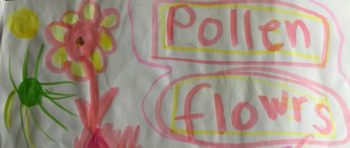Playful Writing Strategies for Kids (Part 3)
 Playful Writing Strategies for Kids (Part 3)
Playful Writing Strategies for Kids (Part 3)
When working with challenged writers, I find that an art project can generate writing recipes for success. During the weeks before the winter holiday break, I created a series of writing assignments to energize challenged writers. Activities included:
- Interview a parent and write the directions for a favorite family holiday dish. Make the recipe and bring a sample to share with your classmates.
- Research your family heritage and write and illustrate a story about how families in your native country celebrate a winter holiday.
- Cut out an evergreen tree and decorate with geometric shapes. Write an act of kindness that you will do during the holidays for your parents on the tree and give the tree to them as a winter holiday card.
- Trace a mitten shape of your hand on construction paper. Cut it out. Write and illustrate a career goal on the palm of the mitten shape.
- Research what you must learn to pursue your career goal and write a story about this career. Some students will write about a career experience that has been shared with them. Others may want to redesign a product they use and describe how they might improve the product as a software developer, clothes designer, or inventor.
How To Motivate Challenged Students
In addition to creative writing, I encourage students to read small excerpts of nonfiction articles and answer comprehension questions in paragraph form. Many students like to write regularly in a journal, create fantasy stories, or write poetry. Some prefer to use a marking pen instead of an erasable pencil or pen.
When students see the results of their efforts, they become more confident in their literacy skills. A few may need assistance with customized writing prompts. For example, when asked to research and write about conservation efforts in their community, some students could write a paragraph and then struggled on what to write next. I would encourage them to create a list of activities that they could complete at home that would support a community’s conservation efforts. These reluctant writers were amazed at how easy it was to fill a full page of writing when making a list.
Next, I taught them how to make a summary statement or statements to complete their writing efforts. Students learned that they could fill a page with practical activities and suggestions. Then they gained confidence to start outlining a story with questions to answer in individual paragraphs.
Sample Writing Prompt Outline
Students are always amazed when I demonstrate how they are already capable writers like professional writers. I assure them that all writers must organize their thoughts and outline a story with content ideas. For example, when writing this post, I wanted to accomplish the following:
- Provide a description with examples on how I might motivate a reluctant writer.
- List specific successful creative activities that I have used in the classroom that work for challenged writers.
- Give an example of what always works for overwhelmed writers when all else fails.
- Review my checklist of writing outcomes for a specific blog to ensure that I have sufficiently covered a topic for the reader.
Through this process, I have learned that my second attempt at writing is typically adequate for a blog. When writing a book, the project is far more intensive and extensive as I am trying to meet the needs of a wide variety of critique partners and readers. I typically have to rewrite a book manuscript three times before it is adequate to submit to publishers. Once the publisher receives my draft, I am typically asked to write several added sections to answer specific questions or expand my explanations or examples.
It is truly a gift to inspire students to communicate their thoughts in writing. As they expand their writing competencies, my ability to pivot and adjust my teaching strategies to meet the needs of diverse students can SOAR as explained in the Student-Engaged Assessment: Strategies to Empower All Learners resource book. Danielle Gentry is featured in the April 25th blog as she explains how she meets second grade common core standard requirements in an ongoing series of writing assignments.